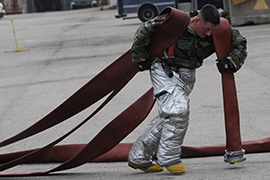- Slug: BC-CNS-Fire Fight,710.
- 2 photos available (thumbnails, captions below)
By Haley Smilow
Cronkite News
WASHINGTON – Voters said no to a plan that would have added one-tenth of a penny to the state sales tax to benefit rural fire districts, but firefighters warn that the need – and the threat to public safety – have not gone away.
“The funding crisis for Arizona fire districts and the Arizona fire paramedic service as a whole is going to continue,” said Bryan Jeffries, the president of the Professional Fire Fighters of Arizona, one of the main supporters of Proposition 310.
The proposition would have increased the state sales tax from 5.6% to 5.7% for the next 20 years to support fire districts. It was rejected by a 52-48% margin, with 1.23 million Arizonans voting against it and 1.14 million supporting.
Unlike fire departments that serve cities and are funded by municipal governments, fire districts are independent of local governments and funded through local property taxes. And that’s the way opponents of the proposition say it should stay, with local beneficiaries footing the bill, not the entire state.
“Not every rural district is in the same position, and that’s why this kind of broad approach didn’t resonate,” said Aimee Yentes, vice president of the Arizona Free Enterprise Club.
But advocates say that everyone in the state does benefit from the services provided by fire districts, and they should share in the expense.
“Urban people drive through rural places, and they expect there to be someone that can come help them if they drive into a tree, or have a car crash, or have a heart attack at the gas station,” said Will Humble, executive director of the Arizona Public Health Association, “and to get that level of comfort, they should have a shared responsibility at providing the resources needed to make that care possible.”
There are 144 fire districts in the state, according to Jeffries and Scott Freitag, fire chief for the Central Arizona Fire and Medical Authority. Those districts directly serve 1.5 million people, according to the Arizona Fire District Association’s website, providing fire response to 15,000 square miles in the state and emergency medical over 27,000 square miles.
Freitag said fire districts will likely have to raise property taxes to generate the funds they need, fund that Proposition 310 would have provided.
“The cap used to be $3.25, but they can raise it all the way to $3.75, as of, I believe, next year,” Freitag said of the assessment caps per $1,000 of property value. “One of the things you’re going to see statewide is an increase in property taxes.”
He and Jeffries fear that fire districts will still fall short when it comes to sufficient funding. Freitag said fire districts will have to find ways to be more resourceful and stretch budgets, or they simply won’t have the proper amount of staffing or modern equipment. But both fear that there will be inevitable cuts as well.
“Imagine if your household or your business had their revenues cut in half, and you’re expected to continue to provide, but half of your revenues are cut,” Jeffries said. “You are going to have to make cuts somewhere and that’s precisely what has happened to Arizona fire districts.”
Humble warns that these cuts could be detrimental to emergency medical services in rural parts of the state. He called the failure of Proposition 310 a “missed opportunity to level up the care in rural parts of Arizona” and explained that if people want care, they should also expect to take some shared responsibility.
“It’s a disappointment,” Humble said. “It was a real opportunity to improve the quality of Emergency Medical Service care in rural Arizona.”
Jeffries agreed, calling the results “very negative for public safety.” He predicted that the proposition’s failure will increase emergency response times, and that funding will continue to be an issue.
Jeffries said he is not sure about next steps, noting that Proposition 310’s sponsor, Sen. Paul Boyer, R-Glendale, will no longer be in the Senate next year. But Freitag was more confident, saying the ballot measure is likely to return in the next election and that the message to voters will not change in the meantime.
“The message to taxpayers from the beginning has been we are not properly funding fire districts,” he said. “That problem still exists.”
For more stories from Cronkite News, visit cronkitenews.azpbs.org.
^__=
Web links:
_ Proposition 310: https://azsos.gov/sites/default/files/prop_310_ballot_format_language.pdf
_ Proposition 310 results: https://results.arizona.vote/#/ballotmeasure/33/0
_ Fire districts association: https://azfiredistricts.org/
^__=
Officials say the hard work will continue for firefighters and rescue crews in rural fire districts across Arizona, without the money they had hoped to raise from Proposition 310, which voters narrowly rejected in November. In this 2012 file photo, Senior Airman Dominic Schultz puts away fire hoses during an exercise at Kunsan Air Base, South Korea. (Photo by Senior Airman Marcus Morris/U.S. Air Force)
Critics said the whole state should not pay for rural fire service, but fire districts say they help anyone, in their districts and often beyond. Here, Airman 1st Class Keith Fussell dons his helmet before a 2014 training exercise in Florida. (Photo by Senior Airman Christopher Callaway/U.S. Air Force)

